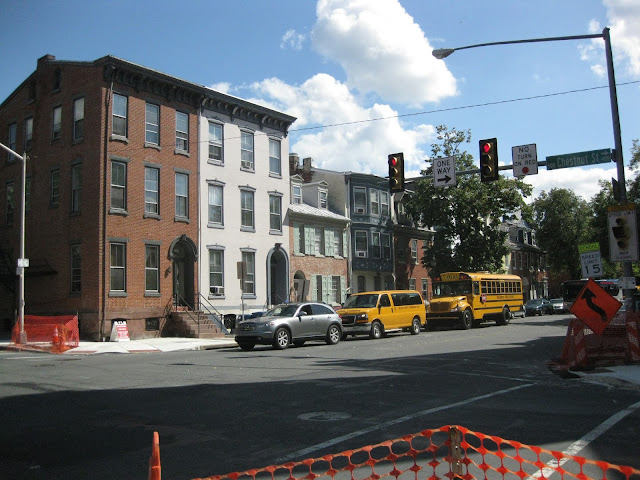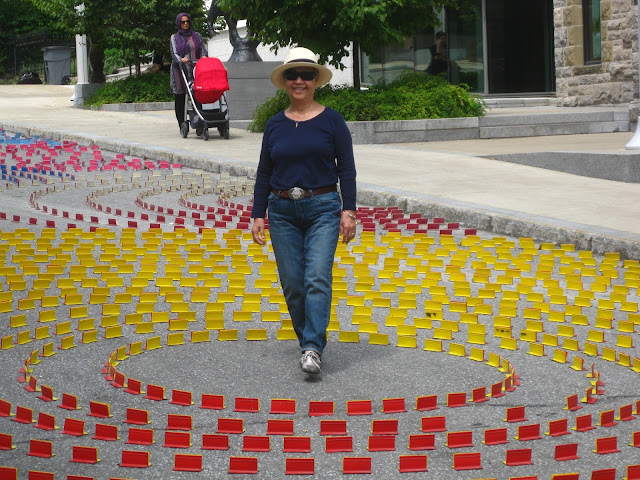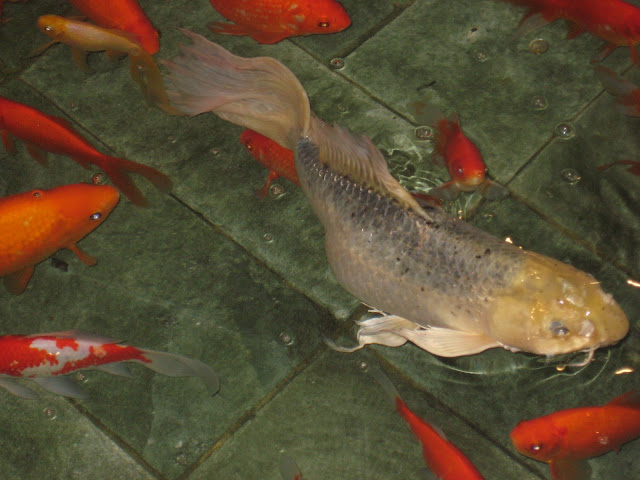September 7
I need a safari jacket for our trip to Thailand next month, and an online search discovered that Cabela’s carries them. That seemed like a good reason to go museum-hopping in Pennsylvania.
After all, Cabela’s, with all the guns, knives, camping gear, and stuffed trophy animals, almost qualifies as a museum itself.
There are others I plan to visit along the way.
The store is farther into Pennsylvania than I remembered. It took an hour to get to the Delaware River Bridge on Interstate 78 and almost another to get to Cabela’s in Hamburg.
I found the way to the store through a sprawl of suburban commerce. I passed the sign on the hill that warns fools like me to focus on what's coming up: “Attention DIP Ahead.
The parking lot is about the size of an airport, and it was almost empty. Great, I’ll have the place to myself. I took photos of some of the stuff outside. The bronze of the Indian and trapper running the rapids, for instance.
The store sits on top of a hill, so I snapped a couple of scenery shots. I don’t know why. They never come out right.
At the store entrance, a man came up to me and said the store had lost power and was closed. The whole area was out of power. That’s why the signals were out, and members of the local fire department were out directing traffic.
The man said they might have power back around 2 in the afternoon.
Cabela’s is why I came to Pennsylvania. So what to do? Give up? Sit in a parking lot for two hours?
I took the only other practical option, which was drive to Reading. Daniel Boone grew up there, but I had never been to the city.
On the way into town, I passed a small point of ground with a large bronze horseman on it. Wrong state for Stonewall Jackson. Who could it be?
I found my way back and was introduced to a local Civil War hero. It was a monument to General David McMurtrie Gregg. The name wasn’t familiar, but he had been involved in several important engagements.
He was a brigadier general in the U.S. Cavalry. His unit and Custer’s stopped an attack by J.E.B. Stuart at Gettysburg. He later led the cavalry at the Battle of Yellow Tavern, where Stuart took the bullet that killed him.
The statue stands in a tiny park on Pennsylvania 61 in an upscale section of Reading. There are six plaques telling his life story. The text is the same as the Wikipedia entry on Gregg.
He was born somewhere else in Pennsylvania, but settled in Reading because it was his wife’s home town. He died in Reading in 1916.
In wandering in search of the main business street (always a good place for a walk) I passed lots of corner stores and service businesses with signs principally in Spanish. I felt right at home.
Parts of the city look remarkably like Paterson, late 19th and early 20th century wood frame row houses that have seen better days.
Still, the place is charming if you like the graceful forms of Federal architecture. Like Georgian, it uses the Golden Rectangle for many of its proportions.
Downtown seemed to be centered around Penn Street.
For about two blocks, Penn is a commercial boulevard. Two lanes each way separated by an island. Still room for angled parking and wide sidewalks. A mix of old and new buildings, mostly occupied.
This was an important thoroughfare in Colonial and Federal times too. Signs commemorate early settlers and Revolutionary War heroes who used to live on what is now the street.
A repurposed bank building sits on the site of an 18th century pub called the Federal Inn. The sign on the sidewalk says George Washington and his staff stayed there when, as president, he led troops to put down the Whiskey Rebellion.
There is even a monument from 1904 that celebrates the Temperance monument.
Plenty of evidence along the street today reassures me that this was a bit of long-gone history, thank Goodness. It was too early to take a sample at any of the bars, but their presence was reassuring nonetheless.
There is also an imposing Neoclassical library, columns and all. After the security guard saw my photo ID, he unlocked the men’s room for me.
Meanwhile back in Hamburg, the signals were working and the firemen gone.
It didn’t surprise me that there were no safari jackets in the store. I’ll buy one online.
Knife selection OK but nothing too attractive, so I’ll wait till my next time in Tennessee, maybe in a few months. Even the Buck knives are made in Red China now.
The stuffed animals are everywhere, and amazing. There are musk oxen on top of a rack of men’s clothes. The central feature of the store is a large fake mountain covered with specimens that range from pumas and elk to brown bears and turkeys.
Needless to say, a shot of that is the photo of the day. My apologies to the vegetarians, but remember, I come from a long line of deer poachers.
The fish aren’t stuffed but alive in the pool. Maybe that touch was a nod to feng shui. Our hotel in Montreal in the edge of Chinatown was built according to feng shui principles, and it had a pool full of fish too.
Easton turned out to be a real surprise.
When I checked in at Days Inn, the lady handed me a map of the neighborhood. The hotel is two blocks from the circle at the center of town. There is more in a six-block radius to eat, drink, and see than I’m going to have time for.
I may not move the car until I leave town.
There are bars, a museum or two, an artists’s alley. Think New Hope combined with Lambertville. It’s a great place to spend a long weekend.
First destination was a four-block walk to a place I’d not heard of: Bachman Publick House, which dates back to 1753. I went there first in the hope that it was still a public house.
The sign outside really cheered me up. It said the place was keeping the colonial traditions alive. What kind of ale would they have?
But no, that’s not the case. It’s a museum where re-enactors portray colonial people doing colonial activities. And it was closed when I got there.
But there is no shortage of alternatives here. A small alley leading off the traffic circle is occupied by a half-dozen beer and food joints.
Pearly Baker’s presented an array of Pennsylvania brews. The food was strictly bar. For me, a great, very rare hamburger and some Brussels sprouts, which were too sweet and too tough to be really good.
Weyerbacher Double IPA, brewed in Easton, has a light fragrance and a bit of sweetness, maybe from the 9 percent alcohol content.
Yards Cape of Good Hope is another double IPA, at 9.7 percent. It’s a cask ale, which means it is carbonated when it is fermented, not force-carbonated at the tap. This may have been the best of the night, and had very good bubbles for a cask ale.
Lancaster Hop Hog was on nitro instead of CO2. It makes for a very smooth drink. Nitrogen gives Guinness stout its characteristic effervescence. The Hop Hog had a faint fragrance but some good hop bite.
It had an almost smoky flavor at the back. Strange, but good.
Evil Genius Stacy’s Mom Citra IPA has a sweet fragrance and an unusual flavor, not nutty, not too bitter, a touch of sour (maybe from the Citra hops), and almost savory like a grain, but not barley sweet. Who the hell is Stacy’s mom?
Penn Brewing IPA is very fragrant—like drinking perfume, Joanna would say. It’s delightfully bitter, and the flavor seems to have almost a touch of sour, but not quite.
The last three ales ranged from 6 to 7.5 percent alcohol
So I managed to walk home and conk out.
Good night, everybody.
Harry



































